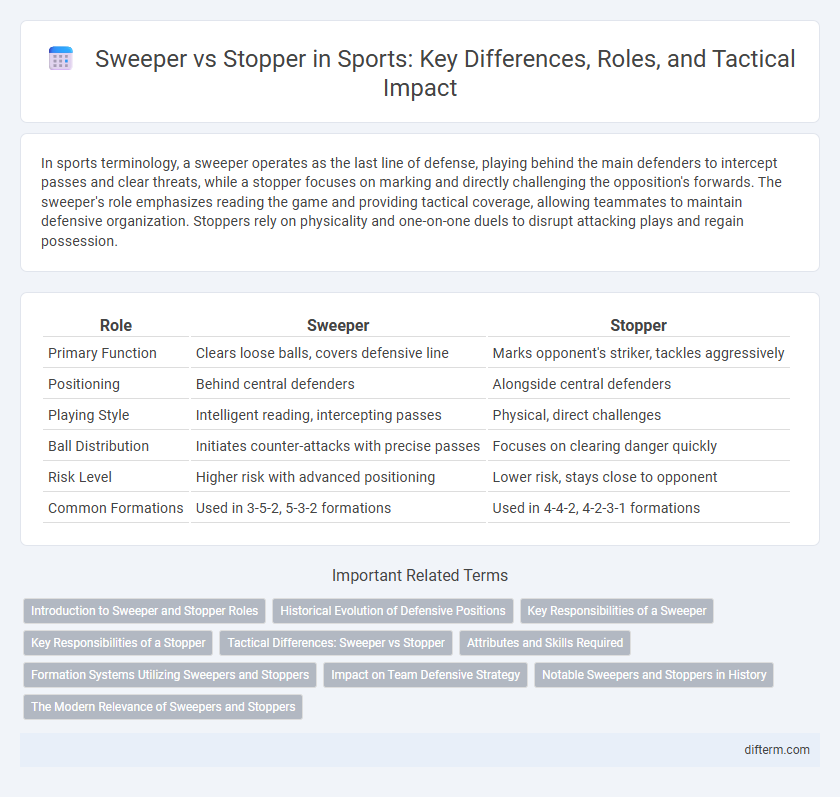In sports terminology, a sweeper operates as the last line of defense, playing behind the main defenders to intercept passes and clear threats, while a stopper focuses on marking and directly challenging the opposition's forwards. The sweeper's role emphasizes reading the game and providing tactical coverage, allowing teammates to maintain defensive organization. Stoppers rely on physicality and one-on-one duels to disrupt attacking plays and regain possession.
Table of Comparison
| Role | Sweeper | Stopper |
|---|---|---|
| Primary Function | Clears loose balls, covers defensive line | Marks opponent's striker, tackles aggressively |
| Positioning | Behind central defenders | Alongside central defenders |
| Playing Style | Intelligent reading, intercepting passes | Physical, direct challenges |
| Ball Distribution | Initiates counter-attacks with precise passes | Focuses on clearing danger quickly |
| Risk Level | Higher risk with advanced positioning | Lower risk, stays close to opponent |
| Common Formations | Used in 3-5-2, 5-3-2 formations | Used in 4-4-2, 4-2-3-1 formations |
Introduction to Sweeper and Stopper Roles
The sweeper, often positioned behind the defensive line, serves as a versatile player who clears loose balls and provides cover for other defenders, emphasizing anticipation and strategic positioning. The stopper, typically a central defender, primarily marks the opposing striker to directly challenge and disrupt attacking plays, showcasing strong tackling and aerial abilities. Both roles are crucial in organizing a robust defensive structure, with the sweeper offering flexibility and the stopper delivering focused man-marking.
Historical Evolution of Defensive Positions
The historical evolution of defensive positions reveals the sweeper as a later tactical innovation, designed to cover the stopper and provide additional goal protection, emerging prominently in the 1960s and 1970s with teams like AC Milan and the Dutch national team. The stopper, traditionally tasked with direct man-marking on the opposing striker, dominated early 20th-century football defensive strategies, emphasizing physicality and close marking. Over time, the sweeper adapted to more fluid defensive systems, enhancing team flexibility and counterattack capabilities while the stopper's role evolved with changes in offside rules and zonal marking trends.
Key Responsibilities of a Sweeper
A sweeper in football primarily focuses on providing defensive coverage behind the main line of defenders, intercepting through balls, and clearing danger from the penalty area. This player is responsible for organizing the backline, anticipating opponents' attacks, and initiating counter-attacks with precise passes. Unlike a stopper who engages directly with forwards, the sweeper ensures defensive solidity by offering a last line of defense and maintaining positional flexibility.
Key Responsibilities of a Stopper
A stopper primarily focuses on marking the main striker, intercepting passes, and blocking shots to neutralize direct attacking threats. Positioned centrally, the stopper engages in aggressive tackles and aerial duels, aiming to disrupt the opponent's offensive plays before they reach the defensive line. Effective communication with teammates ensures coordinated defense and rapid transitions to counterattacks.
Tactical Differences: Sweeper vs Stopper
The tactical difference between a sweeper and a stopper lies in their defensive roles and positioning on the field. A sweeper operates behind the defensive line, acting as the last line of defense with the freedom to intercept passes, clear loose balls, and initiate counterattacks, emphasizing anticipation and spatial awareness. In contrast, a stopper marks the opposing striker closely, focusing on man-to-man defense to block attacks and win tackles, prioritizing physicality and direct engagement.
Attributes and Skills Required
Sweepers require exceptional anticipation, spatial awareness, and ball-playing skills to cover defensive gaps and initiate attacks with precise passing. Stoppers rely heavily on physical strength, tackling ability, and marking skills to challenge forwards directly and disrupt offensive plays. Both roles demand strong communication and positioning but differ in focus: sweepers prioritize interception and distribution, while stoppers emphasize man-to-man defense and aggression.
Formation Systems Utilizing Sweepers and Stoppers
Formation systems utilizing sweepers and stoppers often rely on a flexible defensive backline to enhance adaptability against opposing attacks. The sweeper, positioned behind the defensive line, provides cover by clearing loose balls and intercepting through passes, while the stopper directly marks the striker to disrupt offensive play. Tactical setups like the 3-5-2 or 5-3-2 leverage this combination to balance defensive solidity with the ability to initiate counterattacks.
Impact on Team Defensive Strategy
The sweeper plays a crucial role in enhancing team defensive strategy by providing deep cover behind the defensive line, intercepting through balls, and initiating counter-attacks, which increases overall defensive stability. The stopper focuses on marking the opposing striker closely, disrupting their play and reducing direct scoring opportunities, thereby enabling a more aggressive man-marking approach. Teams utilizing a sweeper tend to adopt a flexible, zonal defense, while those relying on stoppers often implement rigid, man-to-man defensive tactics to maintain pressure on attackers.
Notable Sweepers and Stoppers in History
Notable sweepers such as Franz Beckenbauer revolutionized defensive roles by combining ball control with strategic field vision, while stoppers like Franco Baresi exemplified aggressive marking and tactical interceptions. Beckenbauer's influence stretched beyond defense, often initiating attacks, contrasting with Baresi's focus on neutralizing key opponents through physicality and positioning. Their contrasting styles shaped modern defensive approaches and set benchmarks for sweepers and stoppers worldwide.
The Modern Relevance of Sweepers and Stoppers
The modern relevance of sweepers and stoppers lies in their strategic roles within evolving defensive systems, with sweepers providing crucial cover behind the defensive line while initiating counterattacks, and stoppers focusing on man-marking and intercepting opposition strikers. Contemporary football tactics often blend these roles with zonal defending, requiring players in these positions to demonstrate high spatial awareness, tactical intelligence, and versatility. Teams that effectively deploy sweepers and stoppers gain a balance of defensive solidity and fluid transition from defense to attack, crucial in fast-paced, high-pressing game environments.
sweeper vs stopper Infographic

 difterm.com
difterm.com